
This site celebrates the life and work of sculptor
John Cassidy (1860 - 1939).
TO
OUR GLORIOUS DEAD
WHO FELL IN THE
TWO WORLD WARS
PASS NOT IN SORROW
BUT IN LOWLY PRIDE
AND STRIVE TO LIVE
AS NOBLY AS THEY DIED.
THEIR NAME LIVETH
FOR EVERMORE
History
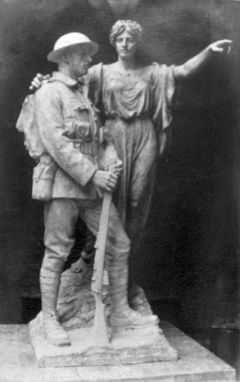
Cassidy's plaster model. Picture from the Manchester Academy of Fine Arts archive.
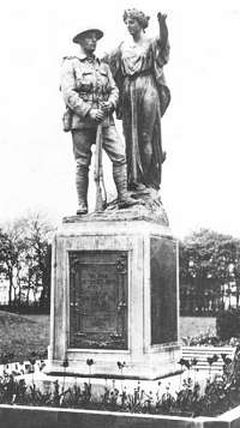
This old picture shows the original bronze plaques.
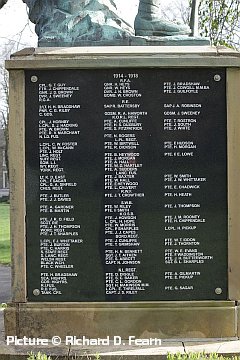
The new look in 2018.
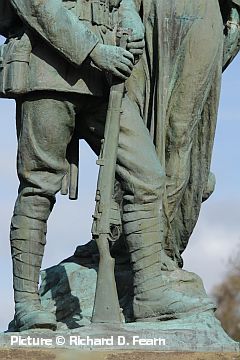
Cassidy's details show typical British equipment. The soldier wears 'puttees' for trench warfare, bandages made of wool serge wrapped around the lower part of the legs, which were thought more serviceable than the knee-length leather boots favoured by some other armies.
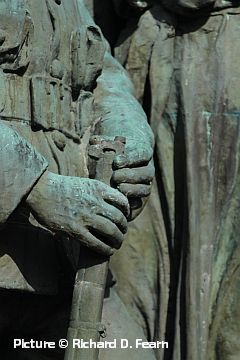
Bayonet question
The rifle is a short-magazine Lee Enfield standard issue at the time. The soldier would also have carried a bayonet, a knife which could be fixed to the rifle barrel for fighting at close quarters.
Cassidy did not, as far as we can discover from this and pictures of other versions of the soldier figure, model the bayonet in the fixed position. However, many years later, members of the local British Legion felt the soldier on the memorial was not in correct 'battle dress' as the bayonet was not in the rifle nor was it in the 'frog' which is the bayonet holder attached to the back of the belt. A replica bayonet was commissioned from a local firm (along with a spare) and fixed in place, only to be stolen not long afterwards.
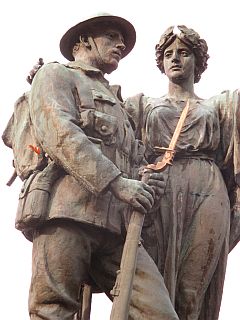
Today, It is considered dangerous to have the bayonet permanently in place, so a replica is bolted in position only for the Remembrance service each November, and kept in a safe place for the rest of the year.
Similar issues have affected other towns. Bridgnorth memorial (by Adrian Jones) in Shropshire has had its bayonet - which was original - replaced twice, for example, the latest version being cast resin.
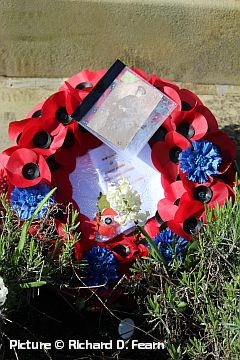
The Names of the Fallen
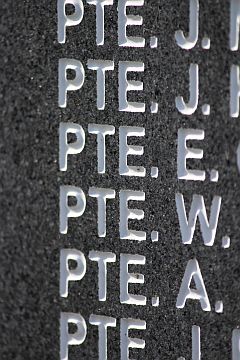
We have transcribed the names from the memorial into the table on the right. The replacement plaques are neatly made, but the layout (based on the earlier version) can be confusing: we have changed the layout to separate the sections more clearly. The many World War I names are arranged, as on the original plaques, by abbreviated name of regiment, whereas the World War II ones are a single - and as is usual for World War II lists - much shorter, alphabetical list. The original plaques may contain errors, and we may well have added others. Corrections are very welcome.
Two soldiers, Private John Cowgill and Sergeant Harry Makinson, are shown as having been awarded the Military Medal, a decoration introduced in 1916 for bravery in battle on land. The East Lancashire Regiment was the local regiment, into which many local men volunteered or were conscripted. Many joined the 11th Battalion, the 'Accrington Pals', which took part in the first attacks of what became known as the Battle of the Somme, on 1 July 1916. Ordered to walk forward directly into German, machine-gun fire, from 720 Accrington Pals in the attack on the hilltop fortress of Serre, 584 were killed, wounded or missing. In all, 58,000 British troops (one third of them killed) were lost on that single day.
A variety of other regiments are represented: the list includes people born in Clayton who had moved away from the area, and others who had moved to Clayton, but on outbreak of war, rejoined their original regiment.
Other Clayton men fought and died at Gallipoli, in Mesopotamia, and elsewhere. More details of the World War I fallen can be found on the excellent Greater Accrington Roll of Honour website.
The 1914-18 dead are almost all from the various regiments of the Army. The 1939-45 list is very different, with the Royal Navy and the Royal Air Force predominating, reflecting Britain's different history in that conflict as well as the realisation by commanders that walking into gunfire to gain a few yards of ground could in most cases no longer be countenanced.
In the modern era, against the 'insurgents' with their suicide bombs and booby traps in the middle and far east, the Army again heads the casualty lists, and the Clayton fatalities of 1952 and 2008 are again from the army.
Soldiers' Stories
The resources on the Internet today allow much to be discovered about the people named on war memorials. As an example, we'll look at the Royal Engineers listed.
2nd Lieutenant Henry Herbert Bradshaw, 74th Field Company Royal Engineers, was an assistant to S.S. Platt, the Borough Surveyor of the town of Rochdale. He married Catherine Howarth on 19 May 1915, and enlisted as a reserve in the Army in November 1915, being called up for service as a Sapper (equivalent to a Private) in May 1916.
Early in 1917, he was selected for training for promotion to the officer grade. While leading his men on the Western Front, probably during the battle for Arras, he was fatally wounded by a shell burst, and died on 22 May 1917. (from an obituary in Building News, 8 August 1917)
Pioneer Charles George Kilby, of 303rd Road Construction Company, Royal Engineers, was born in Mitcham, Surrey in 1865. He was 52 years old when he joined the Pioneer Corps, an army corps for men not considered fit enough to fight, but able to support the Army in building, transport and other tasks, in 1916.
He died of Pneumonia due to Influenza (like millions of others in the disastrous epidemic raging at the time) in a field hospital near Boulogne on 29 November 1918, only just after the armistice was signed to end the War on 11 November. He is buried in a cemetery near the ferry port of Boulogne; his widow eventually, after bureaucratic delays, and writing a letter saying they 'could not live on no money' received a pension of 35 shillings a week to support her and their four children.
Driver Richard Battersby, 74th Field Company, Royal Engineers, was killed in action, aged 32, on 9 June 1918, and is buried at Duisans British Cemetery in northern France, which from May to August 1918, as used by divisions and smaller fighting units for burials from the front line.
Sapper James Alfred Robinson, born in Clayton, was one of 210 men lost at sea when the troopship Cameronia (a commandeered transatlantic liner of the Anchor Line) was sunk by a German submarine U-33 on 15 April 1917, 150 miles east of Malta while carrying 2,650 soldiers from Marseille to Alexandria; he is commemorated on the Chatby Memorial, Egypt.
Driver John Patrick Fitzpatrick, of 296 Army Field Company, was just 22 when he was killed on 14 November 1942 soon after the first landing of the Allies in Algeria at the start of the North African Campaign, and is commemorated on the Alamein Memorial in Egypt.
Sapper Fred Waddington, aged 25, of 238 Field Company, died in Tunisia, on 18 June 1943, some time after the surrender of the Axis forces in North Africa which took place on 11 May, but before the start of the invasion of Sicily in July. During this period the Royal Engineers would have been involved in clearing minefields and other highly-dangerous work.
He is commemorated on the Brookwood Memorial in Surrey, described as a memorial to 'who died during the Second World War and have no known grave ... and [could] not appropriately be commemorated on any campaign memorial in the theatres of war.'
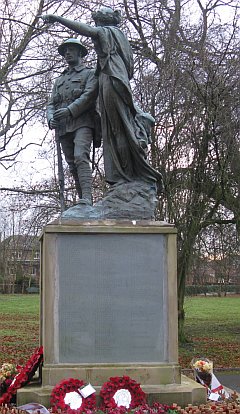
Thanks ...
... are due to Hilary Fearn and her colleagues for the research, Richard D. Fearn for the fine photographs, Andrew Jackson for his Web records, foundry historian Steve Parlanti, and Sheila Dewsbury, archivist of the Manchester Academy of Fine Arts.
Links
UK National Inventory of War MemorialsGreater Accrington Roll of Honour
The Accrington Pals
Commonwealth War Graves Commission
Royal Engineers Museum
Comments welcome at charlie@johncassidy.org.uk
Clayton-le-Moors War Memorial, Lancashire
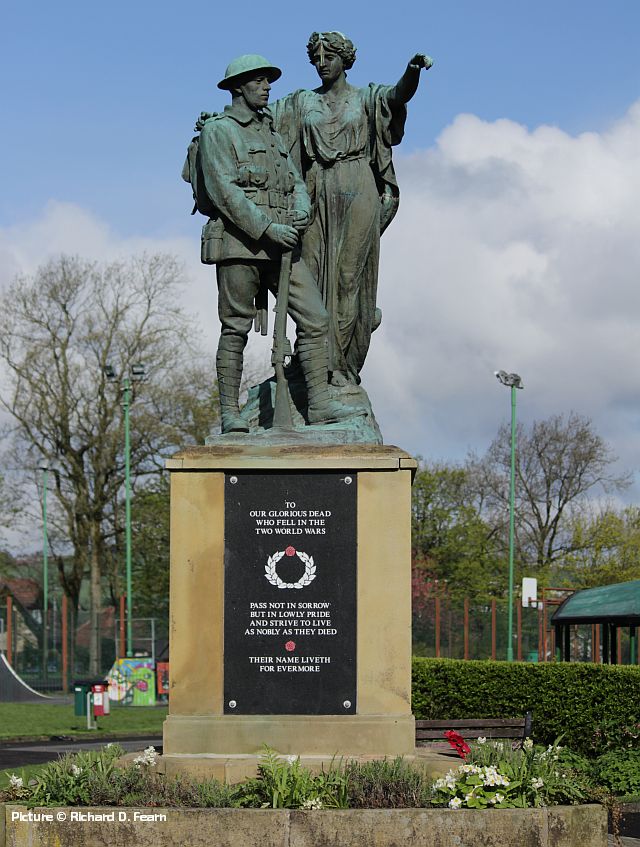
The Memorial
The War Memorial in the Lancashire town of Clayton-le-Moors was unveiled on 6 November 1920 by Major-General A. Solly-Flood. It features a bronze sculpture modelled by John Cassidy and cast by the firm of Parlanti (given as 'Barlatti' in the source article, but there was no such firm, whereas Parlanti of Fulham was a well-known foundry used by sculptors). The report of the occasion in a local newspaper tells us:It was executed by the sculptor, Mr John Cassidy, in a spirit in keeping with the ideals for which, after all, most men fought, and is symbolic of the aspirations of "duty and faith". The chief figure, in the foreground, is that of an infantryman, in full marching order with helmet donned and hand lightly clasped around the foresight of the rifle whose butt rests between his feet, the attitude of patient alertness which, more than all others, is pregnant with memories. Behind him is the symbolic figure of faith, pointing onwards and upwards.The simple stone pedestal carries plaques on all four sides, which are not original and in fact have been replaced more than once. When we visited in 2008 the plaques appeared appear to have their lettering carved into sheets of slate. Apparently the original bronze plaques were stolen - no doubt for their scrap value - some time around 1970. Since then the plaques have all been renewed with the granite versions illustrated here. The front face of the pedestal has the inscription transcribed in the left column, and the other three faces carry lists of names. Sadly, the Cassidy figures themselves remain in a neglected condition, in need of cleaning and re-patination.
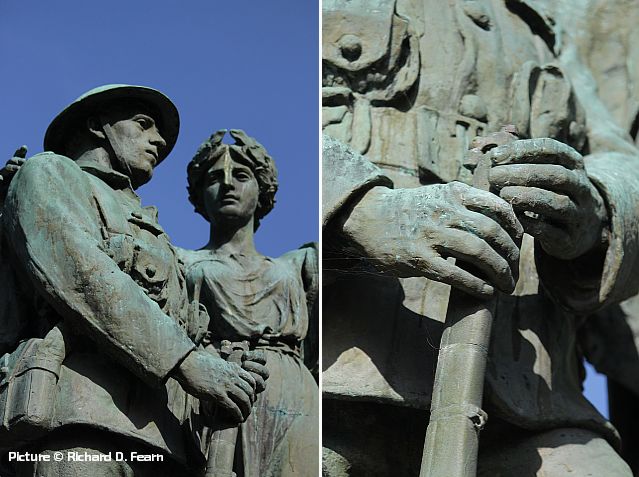
The sculpture is of interest in that it appears to combine Cassidy's two memorial themes into a single work: the soldier (Heaton Moor, Colwyn Bay) and 'Winged Victory' (Eccles, Skipton, Stourbridge, Irlam). In fact it pre-dates all those, and is Cassidy's first War Memorial bronze. The allegorical female figure has taken the soldier in hand and is showing him the way to peace ... or victory?
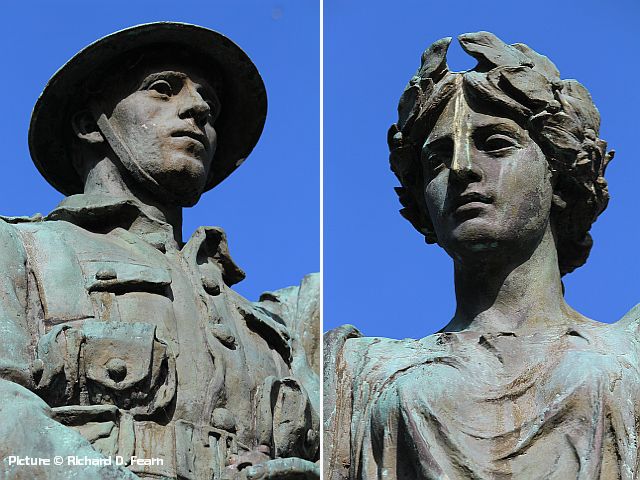
A review of the Manchester Academy of Fine Arts 1920 annual exhibition in the Manchester City News (31 January 1920) mentions 'a small version of the heroic group by Mr John Cassidy that was on view in his studio two months ago and which is now being cast for a town in Lancashire.' This is the one referred to.
Geoff Archer, in his excellent book The Glorious Dead, devotes three pages to this memorial, which he describes as 'interestingly ambiguous':
Despite the obvious
comparison which might be made with the propaganda image
of a mother indicating to her son where his duty lay ('Go!
It's your duty lad, join to-day'), the allegorical nature
of the female figure seems to distance her from such a
specific interpretation ... the iconography of the Clayton
memorial is also remarkably similar to the imagery of
popular cards produced during the war for wives,
girlfriends and mothers to send to their loved ones
overseas.
If Cassidy himself explained the meaning, we have yet to discover any record; to the casual visitor, the work is left to explain itself with only the anonymous poetic inscription as a guide.
The Park
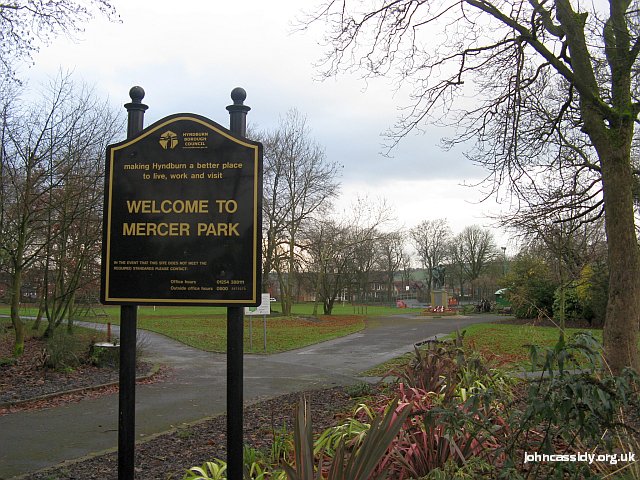
Mercer Park, location of the memorial, is formed from the grounds of Mercer House, home of John Mercer (1791-1866) the 'father of textile chemistry.' He invented Mercerisation, a process for the treatment of cotton fabric.
He provided land and funds towards the building of All Saints Church, next to the Park, as well as a public library and reading room. His house and grounds became a public museum and park under under the will of Maria Mercer, John Mercer's last surviving daughter, who died in 1913. The building still exists, owned by the council, but is no longer used as a museum. Richard Broughton, a historian and trustee of Miss Mercer's will, officially opened Mercer Park in June 1916.
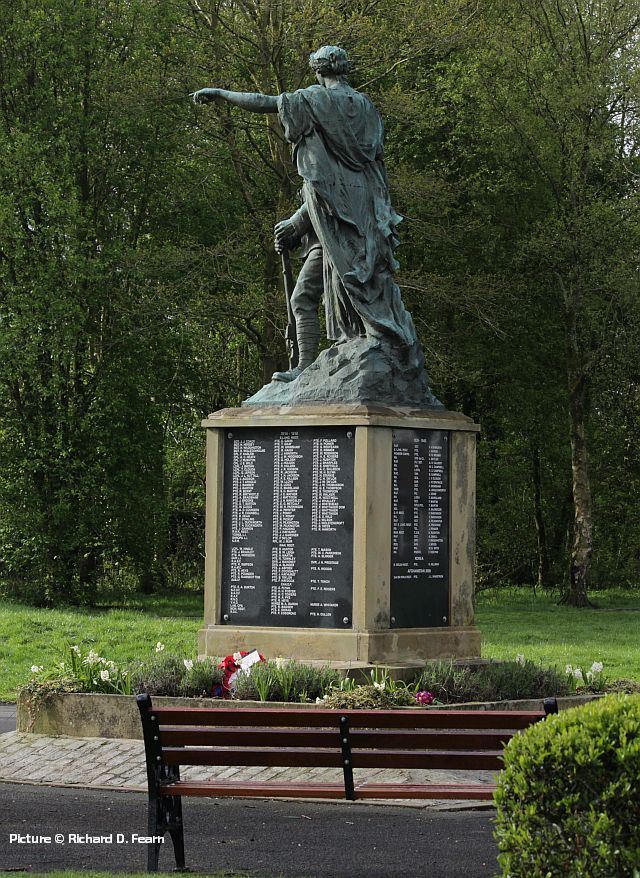
The Town
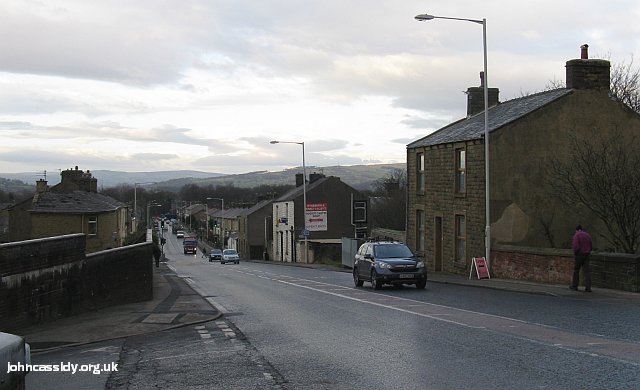
Clayton-le-Moors, at it looks today, is a small town not far from Accrington, which grew around the bridge carrying the road over the Leeds - Liverpool Canal at this point, although a small village had existed here for centuries to serve Clayton Hall, home of the de Clayton family. The view above is from the bridge, looking towards Gt. Harwood, Whalley and Clitheroe, taken in November 2008.
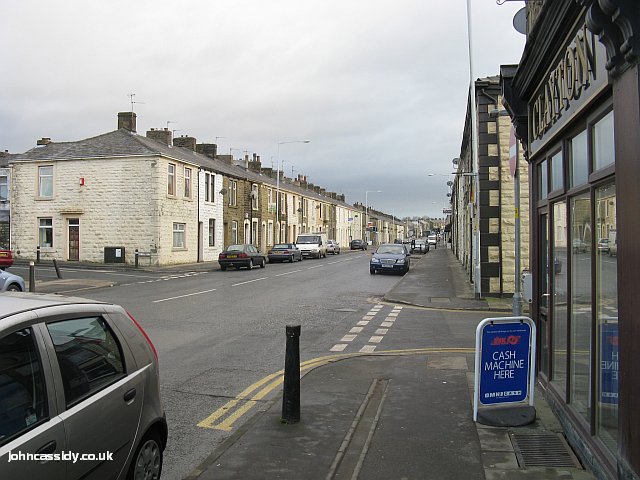
Terraced housing lines the main road, no doubt built for the workers in the local textile factories, all of which had closed by the 1960s. 60 and more years ago a common sight here and everywhere in the industrial towns of the north would have been the housewives busy cleaning their front doorsteps with 'donkey stones' - a 94-year-old lady was found by the local press reviving the procedure in 2009.
The Lists
| 1914-1918 E. LANCS. REGT. SGT. J.J. COADY SGT. H. HERSEY SGT. H. WADDINGTON SGT. H. WOLSTANHOLME CPL. F. HASLEM CPL. A.C. HEATH CPL. J. RUSHTON CPL. J.E. WILD L.CPL. J. BROWN L.CPL. T. CLOUGH L.CPL. G. JEPSON L.CPL. J.L. NUTTALL PTE. J.A. ADDISON PTE. J.T. ARNOLD PTE. J. BAMBER PTE. J. BARTON PTE. R. BERRY PTE. R. BIRTWISTLE PTE. A. BRADSHAW PTE. J. BROOKS PTE. D.T. BURTON PTE. W. CLEGG PTE. A.D. COOKSON PTE. J.R. COUNSELL PTE. R. DEAN PTE. F. DOWLING PTE. J.L.DUCKWORTH PTE. T.H. DUCKWORTH PTE. J. GANNON PTE. E. GAVIN PTE. T. GRAY PTE. W. GRIMSHAW PTE. R. HAIGH PTE. J. HAWORTH PTE. J.W. HIGGINSON PTE. G. HOLDEN PTE. HOLDEN PTE. R. HOLDEN PTE. J.R. HUDSON PTE. R. JACKSON PTE. T.H. JACKSON PTE. P.E. KILLEEN PTE. W. LLOYD PTE. S. LORD PTE. E. MARSLAND PTE. S.H. MARTIN PTE. J.E. MATHER PTE. J.MATTISON PTE. J.H. MAWDSLEY PTE. E.G. METCALF PTE. W.H. PARKINSON PTE. A. PAYNTER PTE. J. PENNY PTE. J.L PENNY PTE. R. PICKUP PTE. H. PILKINGTON PTE. W. PILKINGTON PTE. P. HACKING PTE. F. POLLARD PTE. H. POWER PTE. S. READFEARN PTE. O. RIMMER PTE. W. ROBINSON PTE. A.E. ROGERS PTE. J. RUSHTON PTE. J. SHARPLES PTE. E. SHEFFIELD PTE. A.C. SKILBECK PTE. W.H. SLYNN PTE. H. STARKIE PTE. C.H.TAYLOR PTE. J.W. TAYLOR PTE. J.W. THOMASSON PTE. G.E. THOMPSON PTE. S. THOMPSON PTE. W. WALKER PTE. R. WESTWELL PTE. J. WHALLEY PTE. J. WHITEHEAD PTE. E. WHITTAKER PTE. J. WHITTAKER PTE. T. WHITTAKER PTE. E.S. WILD PTE. J. WILSON PTE. J. WOLSTENCROFT PTE. B. YATES PTE. R. HAWORTH R.W.K. REGT. PTE. J.H. HAYHURST YORKS. L.I. PTE. J.J. GARDNER SHROPS.L.I. PTE. F. TAYLOR K.F.L.R RFLM. J. MUIR MAN REGT. L.CPL. W. HINDLE PTE. J. BRADLEY PTE. A. HODGEON PTE. D. HUNTER PTE. B.W. LEIGH PTE. H.MARTIN PTE. I. MASON PTE. W.C. PARKINSON PTE. A. SLINGER DUR.L.I PTE. R. TOWNLEY R.A.S.C. DVR. A. MAHONEY DVR. L.H. PRESTAGE PTE. E.R. SIMPSON DVR. A. SLINGER |
R.A.M.C. PTE. J. ASPDEN PTE. R. WOODS PTE. R. HEYS PTE. F. COCKSHUTT PTE. R. POUNDER PTE. J. HAYHURST PTE. G. RAMSBOTTOM PTE. B. TAYLOR AUS. L.F. PTE. F. HAYDOCK PTE. L.TENCH CAN.O.F. PTE. E.A. BURTON PTE. E. FLYNN PTE. F.E. ROGERS N.Z.O.F. PTE. H.H. FOSTER S.A.O.F PTE. H.C. TOWERS R.A.F. R.A. PYE R.N.D. PTE. R. HEYS V.A.D. NURSE M.A. BARON NURSE A. WHITAKER LAB.CPS. PTE. R. BADGER MON.REGT. PTE. E.DORAN R.D.C. PTE. P. COSGROVE PTE. H.CULLEN R.F.A. CPL. G.F. GUY FTR. J. CHIPPENDALE GNR. J.D. BROWN DVR. J. SWEENEY GNR. H. HEYS GNR. W.HEYS DVR. J.N.BROWN BOMB. W. CROSTON PTE. J. BRADSHAW PTE. J. COWGILL M.M. PTE. J. GUILFOYLE R.E. 2/LT. H.H. BRADSHAW PNR. C.G. KILBY SAP. R. BATTERSBY SAP. J.A. ROBINSON C.GDS GDSM. R.A. HAWORTH GDSM. J. SWEENEY K.O.R.L REGT. CPL. J. HORNBY L.CPL. S.J. HACKING PTE. W. BROWN PTE. R.V. MARCHANT PTE. A. CUNLIFFE PTE. H.S. DUXBURY PTE. S. FITZPATRICK PTE. T.ROSTRON PTE. J.SOUTH PTE. J.WHITE N/LD FUS. PTE. N. ROGERS L/PL REGT. L.CPL. C.W. FOSTER L.CPL W. MCCANN PTE. J.HOLT PTE. W.BIRTWELL PTE. R. DICKSON PTE. E. HUDSON PTE. H. MORGAN LINC. REGT. PTE. B. KEYWOOD PTE. F.E. LOWE SUFF.REGT PTE. J. MORGAN SOM. L.I. PTE. A. HALL W.Y. REGT PTE. W.D. HARTLEY YORK.REGT. PTE. A. SUDDERS LANC. FUS. LT. K.D. EAST CPL. A. SAGAR CPL. G.A. SINFIELD PTE. J. BAXTER PTE. W. HALL PTE. F. HEYWOOD PTE. W. SMYTH PTE. J.W. WHITTAKER CHES.REGT. PTE. L. CALVERT PTE. E. CHADWICK |
R.W.F. PTE. J. BUTLER PTE. J.T. CROWTHER PTE. H. HEATH PTE. J.J. DAVIES S.W.B. PTE. A GARDNER PTE. B MARTIN PTE. W. RILEY PTE. F. SMITH PTE. J.THOMPSON K.O.S.B PTE. J.R.O. FIELD PTE. J. HOWSON PTE. J.M. ROONEY SCOT.RIF. K.CPL. H. HOPE PTE. E.H. CHIPPENDALE PTE. J.H. THOMPSON PTE. W. MORRIS WORC.REGT. CPL. P. SHARPLES L.CPL. H. PICKUP PTE. J.T. SHARPLES PTE. J.C. CAPES BORD.REGT. L.CPL. F.J. WHITTAKER PTE. J. CUNLIFFE PTE. W. T. IDDON PTE. J. BURTON PTE. T.GRIMSHAW PTE. J. THORNTON PTE. C. HARRIS S.STAFF.REGT. PTE. H.N. BENNETT PTE. W.E. EVANS S.LANC.REGT. SGT. J.T. AITKEN PTE. F. WADDINGTON WELSH REGT. PTE. S. ABBOTT PTE. J.H. BUTTERWORTH BLACK W'CH CAPT. N. JOHNSON SGT. B.L. SHARPLES PTE. C. WHEELER L.N.L. REGT. PTE. H. BRADSHAW PTE. D. DIGGLE PTE. A. GILMARTIN SEA. HIGH'RS. PTE. S.C. BAKER PTE. E. PICKUP GOR. HIGH'RS. PTE. C.L. GORDON R.I. FUS. SGT. H. MAKINSON M.M. R.D.FUS. L.CPL. E.THRELFALL PTE. G. SAGAR TANK CORPS. CAPT. J.S. RILEY 1939-45 SGT. F. ASHWORTH, R.A.F. PTE. R.N. BROWN, PIONEER CORPS STO.1ST.CL. L. BUTLER, R.N. FLT.SGT. A.H. CALVERT, R.A.F. STO. W.C. CAMPBELL, R.N. L/STO. A.S. CAMPBELL, R.N. TPR. B. CAMPBELL, R.A.C. SFA. L.V. CLOUGH, R.N. DVR. J. FITZPATRICK, R.E. SGT. F. GRIMSHAW, R.A. PTE. A. HOULDSWORTH, S.W.B. F/O J. HOWE, R.A.F. L/SEA C. MARSLAND, R.N. SGT. F. MARTIN, R.A.F. STO. 2ND.CL. T.MARTIN, R.N. PTE. R. MCGREGOR, K.S.L.I PTE. F. PARKINGTON,Q.R.REGT. GNR. T. PARKINSON, R.A. SGT. A. PILKINGTON, R.A.F. PTE. A. PRESTAGE, 1ST E. LANC. REGT. TEL. J. RENDER, R.N. C.S.M. H. RUSHTON, MAN.REGT. SGT. A. SMALL, R.A.F. SPR. F. WADDINGTON, R.E. DVR. J. WOOD. R.C.S. P/O. W.B. YATES, R.A.F. P.O/STO. F. KENYON, R.N. PTE. J. BARON, E.LANC.REGT. KOREA 1952 PTE. C. HILLMAN, R.WELSH. REG. AFGHANISTAN 2008 PTE. J.L. RAWSTRON, 2ND BN. PARA. REGT. |
Of the Cassidy-designed war memorials we have visited, this is the only one to have added the name of a soldier fallen in battle in the year 2008. Private Jason Rawstron of the 2nd Battalion, Parachute Regiment, aged 23 and born in Clayton-le-Moors, was killed when his patrol were engaged in an exchange of fire with the Taliban in Afghanistan on 12 September 2008. (Ministry of Defence report and tribute.)
Update
At the start of 2014 a small group who attended the Family History Class at Clayton-le-Moors library decided to research the lives of the 225 men from Clayton-le-Moors who died in WW1 and who are listed on the Mercer Park Memorial. In 2018 group member Mrs Hilary Fearn made contact with us and has been of great help in providing accurate and additional information about the soldiers and also the story of the bayonet. The table above has now had various transcription errors and other matters corrected.The group has compiled biographical notes on each of the people listed, and with permission of the families we have compiled an extra web page which includes three of those stories, augmenting our original examples as found in the left column of this page.
To visit the extra page, follow this link.
Notes on the entries
Another record of casualties from Clayton-le-Moors and other Accrington area settlements is the Greater Accrington Roll of Honour website, which includes some names which are not listed correctly on the memorial: Arthur Christian (who is on the memorial as as A.C. Heath). Henry Haworth (a duplicate for Henry Haworth Foster) , William Heyhurst (incorrect, but two brothers John and Joseph Heyhurst were killed).
Walter Pull and John Edward Johnson are on local Church memorials, but moved to Accrington and are on the Accrington Roll of Honour.
William Aspinall Private 142893 of the Machine Gun Corps was killed in action on the 29th March 1918. He was born in Great Harwood and in 1911 was living with his family in Maple Street, Clayton-le-Moors. He is Remembered on the Baptist Church Memorial but is not on the Mercer Park Memorial as at the time of his death his parents were living in Blackburn.
Some soldiers who died after the memorial was erected and are commemorated elsewhere: Edward Patrick Crosby, East Lancs Battalion RFA, died 27 May 1921, military grave in St. Mary's graveyard; John Edward Chippendale died in 1921 from Tuberculosis. Stephen Kay, on All Saints Church war memorial, not on Mercer Park memorial, died 7 December 1924.
Pte. J. Barton appears to refer to William James Barton, who survived the war.
Driver J.N. Brown was awarded the Military Medal in July 1918.
Pte. E. Chadwick is Eadeauf Chadwick, born Accrington,on Accrington Roll of Honour but wife and children lived in Clayton-le-Moors at time of his death.
Pte. A Gardner: Albert Gardner correct but spelt Gardiner on military records.
Pte. W.D. Hartley: Born Walter Denison, mother unmarried. She married John Henry Hartley in Bradford in 1893. He was known as Walter Denison Hartley
Pte. H. Heath: Henry Heath joined the Royal Welsh Fusiliers in 1915 fought in France and was treated in hospital there in Dec 1916. In January 1917 he was sent to England to recuperate and there are no further records of him. He came back to Clayton-le-Moors as Harry Brady and died in Clayton-le-Moors in 1945.
Pte R. Heys, who died 31 August 1915 and buried at sea.appears on the memorial twice under R.A.M.C. and R.N.D.
Pte. B. Heywood: Born as Heywood, moved to Lincolnshire and changed his name to Haywood. Military records for Lincolnshire Regiment under Haywood.
Captain N. Johnson is listed on the memorial and the Roll of Honour; his actual name was Nelson Gordon Johnstone and appears to have no connection with Clayton.
Sgt. H. Makinson. Sergeant Harry Makinson MM. Born Henry, known as Harry.
Pte. H. Morgan: Henry Morgan, 10th Battalion the King's Liverpool Regiment.
Pte. W.C. Parkinson: Born Walter Chew, adopted by the Parkinson family, known as W.C. Parkinson, military records under Walter Chew.
Pte. A. Paynter: Arundel Paynter, known as Arnold, records under Arundel.
Sgt. B.L. Sharples: Awarded Military Medal July 1918.
Pte. J. Sharples: Not Joseph Sharples. 15542 on ROH buried at Brindle. No connection with Clayton-le-Moors.
Pte. J.W. Thomasson: Name spelt wrong on war memorial (should be Thomason)
Nurse A. Whitaker: Ada Whitaker, VAD Nurse buried at Dill Hall Lane Cemetery. No headstone
Pte. J. Whittaker: Jacob Whittaker, Private 20993, lived in Accrington, sister lived in Clayton-le-Moors.
Written by Charlie Hulme, August 2012. Updated August 2019.